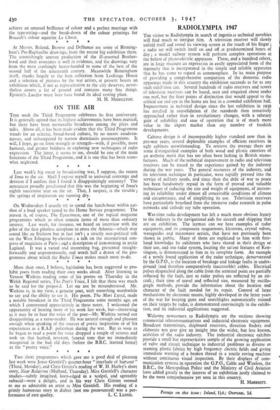RAD I OLYMPIA 1947
THE visitor to Radiolympia in search of ingenio.is technical novelties will find much to intrigue him. A television receiver will slowly unfold itself and reveal its viewing screen at the touch of his finger ; a radio set will switch itself on and off at predetermined hours of day ; a model railway system will perform complex operations at the behest of photo-electric apparatus. These, and a hundred others, are in large measure an expression in easily appreciated form of the ingenuity that is incorporated in the simple and reliable apparatus that he has come to regard as commonplace. In its main purpose of providing a comprehensive comparison of the domestic radio apparatus made in this country the exhibition succeeds as far as any such exhibition can. Several hundreds of radio receivers and scores of television receivers can be heard, seen and enquired about under one roof, but the finer points of distinction that would appeal to the critical ear and eye in the home are lost in a crowded exhibition hall. Improvement in technical design since the last exhibition in 1939 has resulted in consolidation of the standards then tentatively approached rather than in revolutionary changes, with a salutary gain of reliability and ease of operation that is of much more value in the export market than any number of freakish developments.
Cabinet design is of incomparably higher standard now than in pre-war years, several deplorable examples of efficient receivers in ugly cabinets notwithstanding. To retrieve the average there are some distinguished examples of both wood and plastic exteriors of an aesthetic merit that has too often been lacking in British manu- factures. Much of the technical improvement in radio and television receivers can be traced to the experience gained by the industry during the war years. The general resources of the industry, and its television technique in particular, were rapidly pressed into the service of military needs, and since then the debt of war to peace has been handsomely repaid in the form of proved and valuable techniques of reducing the size and weight of equipment, of increas- ing its reliability under almost all conceivable conditions of climate and circumstance, and of simplifying its use. Television receivers have particularly benefited from the intensive radar research in pulse networks and cathode ray tube operation.
War-time radio development has left a much more obvious legacy to the industry in the navigational aids for aircraft and shipping that are on exhibition. The layman can see here examples of radar equipment, and its component magnetrons, klystrons, crystal valves, waveguides and microwave aerials, that have not previously been shown in public. Many of them are explained to him with first- hand knowledge by exhibitors whc have shared in their design or their use, and one radar system, locating the salient features of Ken- sington, is demonstrated to him in its complete form. An example of a newly found application of the radar technique, demonstrated by the G.P.O.' is the location of breakage and leakage faults in under- ground (and therefore comparatively inaccessible) cables. Electrical pulses despatched along the cable from the terminal point are partially reflected by the fault, just as radar pulses are reflected by an air- craft ; their time of travel and reflected size, measured by oscillo- graph methods, provide the information about the location and character of the fault needed for its repair. Control of large mechanisms by electronic means, highly developed in the latter years of the war for keeping guns and searchlights automatically trained on their targets by radar, is demonstrated convincingly in the exhibi- tion, and its industrial applications suggested.
Welcome newcomers to Radiolympia are the sections showing commercial telecommunications and industrial electronic equipment. Broadcast transmitters, shipboard receivers, direction finders and elaborate test gear give an insight into the wider, but less known, activities of the radio industry. The industrial electronic exhibits provide a small but representative sample of the growing application of valve and circuit technique to industrial problems as diverse as seaming plastic fabrics by high frequency electric fields and giving immediate warning of a broken thread in a textile roving machine without continuous visual inspection. By their displays of com- munication systems in operation the G.P.O., Cable and Wireless, the B.B.C., the Metropolitan Police and the Ministry of Civil Aviation have added greatly to the interest of an exhibition justly claimed to be the most comprehensive yet seen in this country.
H. MARRIOTT.


































 Previous page
Previous page